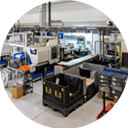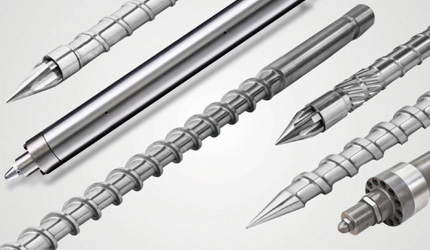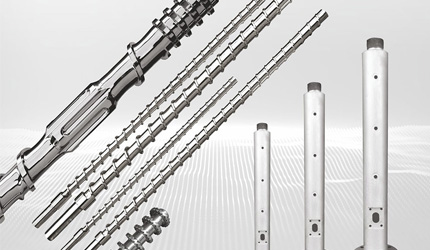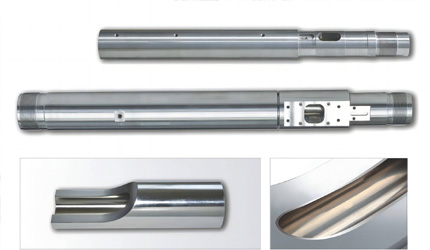Injection Screw and Barrel Design Challenges: Solutions for Professionals
Injection Screw and Barrel Design Challenges: Solutions for Professionals
The Core Role and Design Principles of Injection Screws and Barrels
Functional Role in the Plasticizing–Injection System
The injection screw and barrel are vital parts of any injection molding machine. The screw pushes resin pellets forward, uses shear and pressure to melt them, and measures the liquid plastic before injection. The barrel holds everything, keeping heat and pressure steady. If either part is poorly made or doesn’t fit well, the melt quality suffers. Cycles become uneven, and parts come out flawed. A good screw–barrel pair makes resin flow smoothly from solid to liquid. It keeps pressure and heat stable, avoiding unmelted bits, hot spots, or material damage.
Structural Elements — Feed, Compression, and Metering Sections
An injection screw has a standard layout: a feed zone, compression zone, metering zone, and a check valve or screw tip to stop liquid plastic from flowing back during injection. The barrel has a long bore, heating bands or jackets, cooling channels, flanges, and a nozzle connection. The barrel must stay lined up with the screw’s center, with very little off-center shift.
Design Principles — L/D Ratio, Compression, Geometry, and Backpressure
The screw’s length-to-diameter (L/D) ratio affects how well it melts and mixes resin. Longer screws mix better but can overheat resin if not handled carefully. The compression ratio sets how well solid resin turns to liquid. Channel shape, pitch, and backpressure control melt evenness and flow steadiness. A tiny change in backpressure can strongly affect melt thickness and shot consistency. This is why careful machining and heat control are so important in industrial design.
Design Challenge #1 — Wear, Corrosion, and Adhesion
How Material Formulations Affect Surface Durability
Modern resins often have fillers like glass fiber or calcium carbonate, flame retardants, or recycled materials. These cause problems:
-
Abrasive wear: Fillers scrape screw flights and barrel walls, slowly wearing down metal.
-
Corrosive attack: Halogen-based flame retardants react at high heat, harming surfaces.
-
Adhesion: Liquid plastic sticks in tiny surface dents, causing black spots or color mix-ups.
For example, nitrided steels like 38CrMoAlA reach a hardness of HV 900–1000, which helps resist wear. Bimetallic barrels with tungsten carbide liners hit 58–62 HRC hardness. Hard-chromed screws give smooth surfaces that resist sticking and make cleaning easier.
Choosing Materials and Coatings to Resist Wear
To fight wear and corrosion, designers use nitriding, bimetallic layers, or hard coatings. Nitrided steels work well for common resins. Bimetallic liners, joined by centrifugal casting, handle rough fillers like glass fiber. Chrome or titanium coatings add smoothness and resist rust for long production runs. Examples include the Bimetallic Injection Molding Screw with tungsten carbide overlay, which fights abrasion and chemical damage, and the Injection Molding Barrel with Bimetallic Liner (38CrMoAlA base), which balances corrosion resistance and heat flow. The Coated Injection Molding Screw (Chromium-plated) has a smooth surface to cut buildup during color changes.
Reducing Adhesion and Preventing Carbonization
Adhesion can be reduced by shape and surface finish. Polishing to Ra ≤ 0.4 µm removes tiny dents where melt sticks. Smooth channel shifts and rounded corners avoid dead spots. For high-heat resins like PET, chrome-plated surfaces stop carbon buildup and ease cleaning.
Design Challenge #2 — Melting Efficiency and Mixing Uniformity
Heat Transfer and Shear Control in the Melting Stage
During melting, barrel band heat must balance the shear heat from screw turning. Too much shear hurts the resin. Too few leaves, pellets solid. Engineers adjust compression ratios, screw speed, and heat zones to balance these heat sources.
Barrier and Mixing Section Strategies
Barrier screw designs split solid and liquid phases for even melting. Maddock or pin mixing sections spread material for a steady color and filler. Dual-flight shapes improve mixing spread and flow. These steps ensure even melt temperature and thickness. A Nitrided Injection Molding Screw with a carefully cut barrier section steadies output pressure and boosts color consistency. This is key for automotive connectors and electrical housings where melt quality is critical.
Evaluating Long (High L/D) Screws for Advanced Polymers
High L/D screws improve mixing for tough engineering plastics but need strong heat control to avoid stress. Designs usually range from L/D 18–25 based on resin type. For PP and PE, longer screws help with melting. For PVC, shorter ones prevent damage.
| Resin Type | Recommended L/D | Advantage | Limitation |
| PP, PE | 18–22 | Improved melting | Slightly higher energy use |
| PA, PC | 20–25 | Better dispersion | Thermal stress risk |
| PVC | 14–18 | Prevents degradation | Lower throughput |
Design Challenge #3 — Thermal and Mechanical Stress Control
Barrel Heating Bands, Cooling Design, and Temperature Zoning
Steady heat zoning across the barrel is crucial. Multi-zone heating bands and cooling channels keep melt temperature even. Uneven heat causes hot spots, damaging resins and speeding wear. Well-placed zones limit heat swings to ±1–2 °C, keeping thickness and part weight steady. The Injection Molding Barrel (up to 8000 mm) uses separate heating and cooling channels for precise heat control, cutting wear from heat cycles.
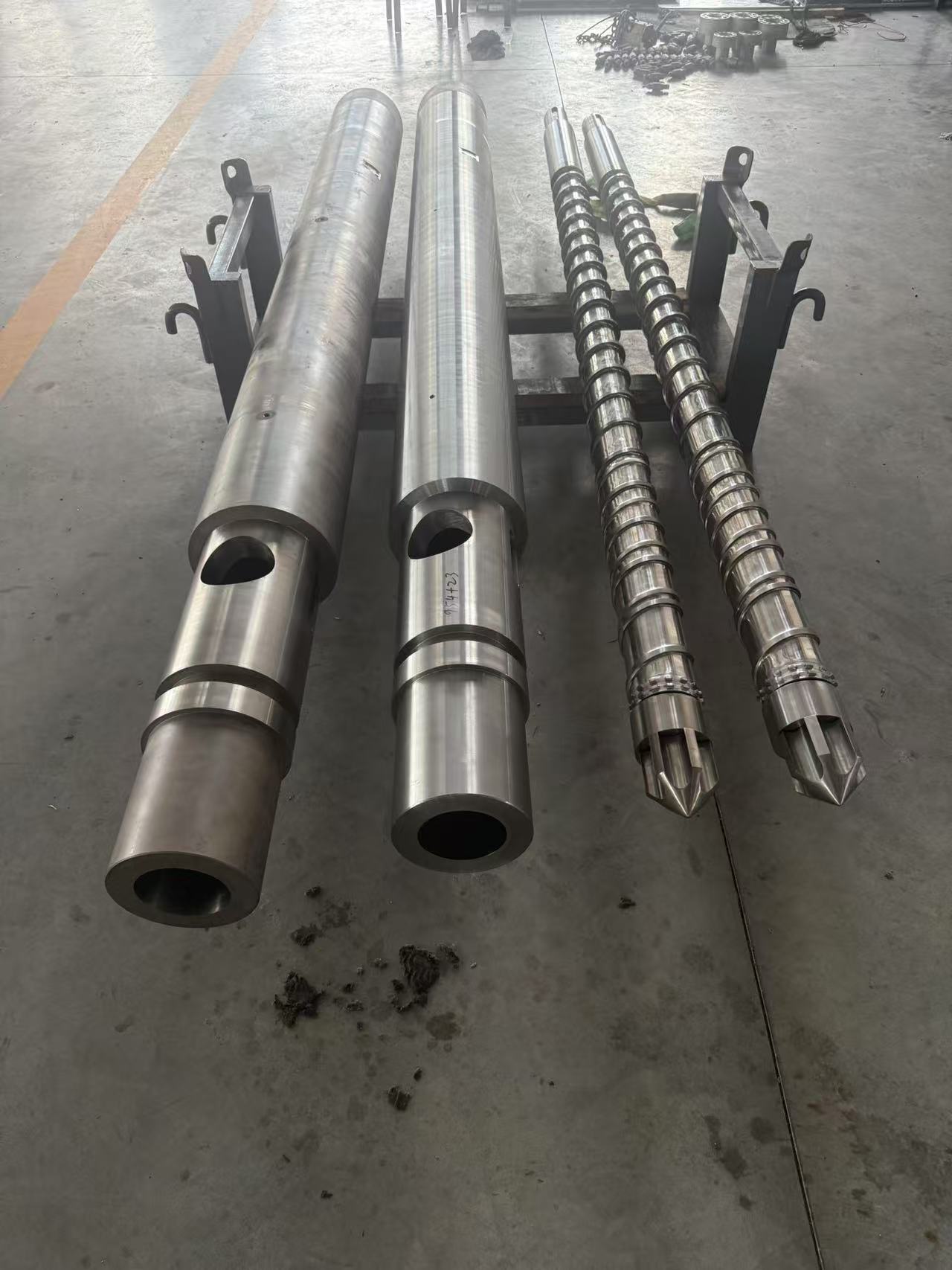
Screw-Barrel Clearance, Tolerance Control, and Thermal Expansion Compensation
The gap between screw and barrel must stay very tight—around 0.02 mm in many cases. A wide gap causes melt leaks and pressure loss. A narrow gap increases friction and force. Precise CNC grinding and honing keep this gap steady. Heat treatments like quenching and tempering ease internal stresses before nitriding, stopping tiny shape changes.
Stress Concentration, Fatigue, and Screw Head Design Details
High force often wears out the screw head and drive connection. Smooth section shifts and rounded corners cut stress buildup. Finite Element Analysis (FEA) models help find weak spots and guide shape changes to make parts last longer.
Design Challenge #4 — Lifetime Prediction, Refurbishment, and Maintenance
Evaluating Screw and Barrel Lifetime
Over time, screws and barrels wear out, cutting output and melt steadiness. Signs include higher melt pressure, uneven part weight, and flight wear over 0.1 mm. Regular checks and measurements help plan maintenance before big problems hit.
Refurbishment vs. Complete Replacement
Repair options include re-nitriding to restore surface hardness, alloy spray-welding to rebuild worn flights, and precise grinding to fix alignment. Re-nitriding often brings hardness back to HV 900. New alloy layers nearly restore original wear resistance. Experts say screws fixed with re-nitriding and hardfacing can regain most performance if caught early. Results depend on base material quality and repair timing.
Preventive Maintenance and Monitoring Methods
Preventive maintenance is just as vital. Regular hardness tests, ultrasonic checks, and bore measurements spot early wear or cracks. Tiny surface exams catch pitting or adhesion before they harm output. A solid maintenance plan keeps the melt steady and cuts long-term costs.
Selection and Solution Recommendations — How to Choose the Right Screw and Barrel System
Selecting Geometry and Material Based on Resin Type
Matching the screw and barrel setup to resin type is key.
| Polymer Type | Screw Type | Barrel Material | Treatment |
| Polyolefins (PP, PE) | General-purpose | 38CrMoAlA | Nitrided surface |
| Engineering plastics (PA, PC) | Barrier / mixing | 42CrMo + Inconel | Bimetallic liner |
| Filled or reinforced resins | Solid carbide | Hastelloy or CPM 9V | Hardfaced coating |
Choosing the right shape boosts melt quality and saves energy.
Balancing Production Scale, Lifespan, and Cost
For small or test runs, standard nitrided screws give quick returns. For high-volume work, bimetallic or carbide designs cut downtime and maintenance needs. Modular screw segments ease future material switches or partial fixes.
Comparing Standard, Custom, and Modular Designs
Standard designs are cheap and fast to make. Custom screws fine-tune mixing and residence time for specific resins. Modular systems blend both benefits—easy upkeep and precise flow control—gaining favor among advanced processors.
| Design Type | Benefit | Typical Use |
| Standard | Low cost, fast delivery | Commodity resins |
| Custom | Optimized flow & shear | Engineering polymers |
| Modular | Easy section replacement | Multi-resin factories |
About CHUANGRI SCREW — Products and Advantages in Injection Screw & Barrel Design
Company Overview and Engineering Approach
At CHUANGRI SCREW, we’ve worked over 30 years to improve injection and extrusion screw and barrel design. Our 12,500 m² facility in Zhoushan handles CNC machining, nitriding, bimetallic coating, and size checks under ISO 9001 standards. We see the screw and barrel as one system. We design based on resin behavior, output rate, and processing heat, using tests and data to refine shapes and alloys.

Key Product Lines Related to Injection Screw & Barrel Design
Our injection products include:
-
Bimetallic Injection Molding Screw – built for filled polymers and long life.
-
Injection Molding Barrel with Bimetallic Liner (38CrMoAlA base) – made for corrosion resistance and heat control.
-
Solid Carbide Screw – suited for high-force, high-load tasks needing strength and precision.
Every part is checked for alignment, hardness, and surface finish before shipping. By keeping design, production, and quality control in-house, we ensure steady quality, shorten lead times, and provide reliable parts for customers worldwide.
Strengths — Technical Precision and Service Philosophy
-
Full production: Every step, from raw steel to final checks, happens in-house.
-
Quick delivery: Standard models ship in three days.
-
Global shipping: Close to Ningbo and Shanghai ports for fast delivery.
-
Ongoing research: We invest in alloy and coating advances to match new resin technologies.
Our goal is to help processors get steady, repeatable, and efficient plasticizing through top-notch engineering.
FAQ
Q: What causes wear and corrosion in injection screws and barrels?
A: Rough fillers like glass fiber and chemicals like halogen-based flame retardants harm surfaces over time. Using nitrided steels or bimetallic coatings extends service life.
Q: How can the melting uniformity be improved?
A: Barrier or mixing-section screws balance shear and heat. Precise multi-zone heating stops cold spots and uneven thickness.
Q: Is refurbishment better than replacement for worn screws?
A: Often, yes. Re-nitriding or overlay welding restores much of the original performance at lower cost and less downtime than replacement.
Q: What is the best L/D ratio for injection screw design?
A: Usually 18–22, depending on resin type, thickness, and processing speed. Sensitive materials may need shorter ratios to avoid overheating.

